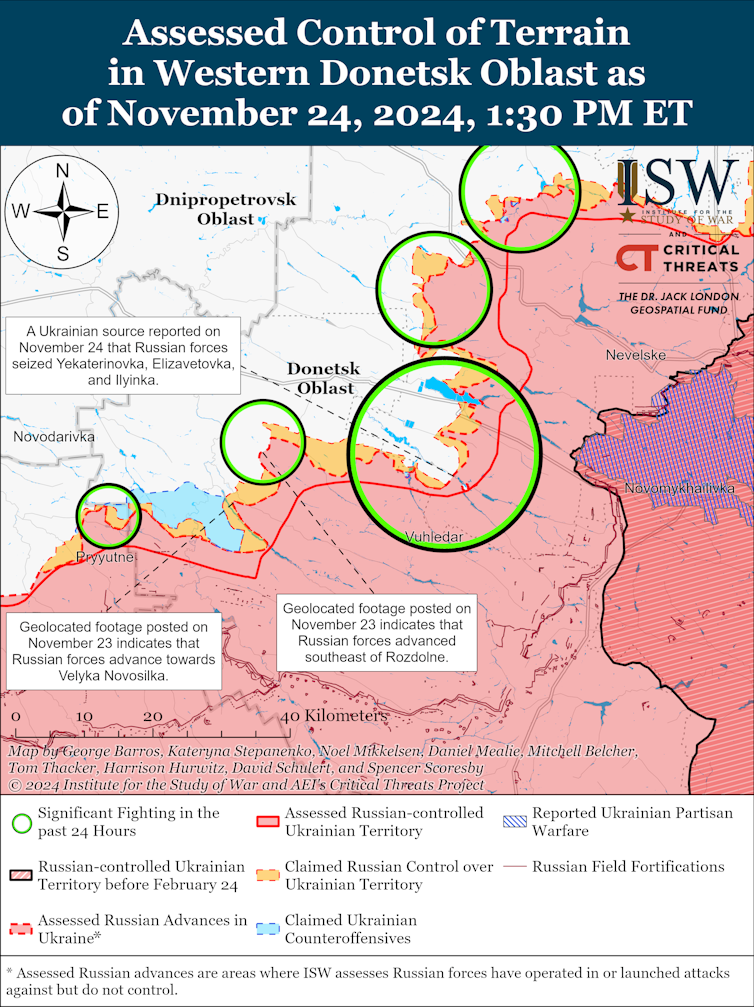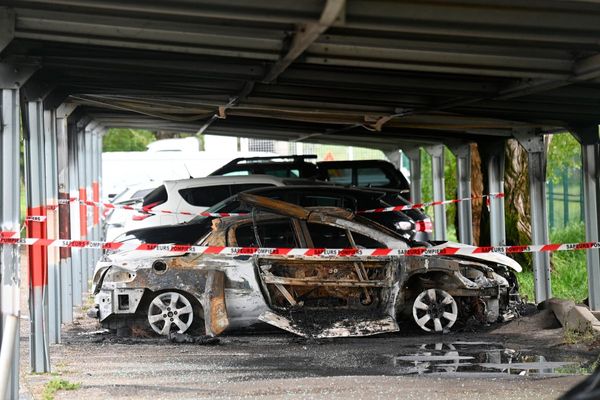The war in Ukraine is at a critical juncture. Kyiv has been given permission to use western-supplied Atacms and Storm Shadow missiles against targets inside Russia. It did so as soon as that permission was granted, with strikes against Russian military facilities in the Bryansk and Kursk regions.
Moscow’s response to the strikes has been twofold. First, the Russian president, Vladimir Putin, approved changes to his country’s nuclear doctrine to lower the threshold for the use of nuclear weapons. It also launched an intermediate-range ballistic missile – Oreshnik, or Hazel Tree – at an arms factory in the Ukrainian city of Dnipro.
This – so far carefully calibrated and choreographed – tit-for-tat indicates a further, gradual escalation of the war effort by both sides. It has been accompanied by a steady advance of Russian forces in eastern Ukraine and a continuation of the Kremlin’s efforts to cause maximum damage to Ukraine’s critical infrastructure.
Both sides are acting in anticipation of Donald Trump’s inauguration in January, Trump has repeatedly committed himself to ending the war in Ukraine in 24 hours. Meanwhile, Ukraine’s European allies are struggling to maintain their unified front of support in anticipation of a US withdrawal of aid under the incoming Trump administration, as well as scepticism from the likes of Hungary’s Viktor Orbán.
The war has taken a huge toll on Ukraine. Six million people fled the country and an additional four million people are internally displaced. The country is experiencing increasing levels of poverty and food insecurity and a bill for reconstruction of nearly US$500 billion (£396 billion) and counting. More than 30,000 Ukrainian servicemen were killed in the first two years of the war alone, with countless more wounded and missing. And a conservative estimate is that least 12,000 civilians have been killed and 30,000 injured.
After 1,000 days, public disillusionment is becoming evident. Recent Gallup polls make for interesting reading: there is general agreement on the need for the war to end, but far less concord on how to end it.
More than half of Ukrainians polled by Gallup (52%) agree that: “Ukraine should seek to negotiate an ending to the war as soon as possible”, while only 38% want the country to “continue fighting until it wins the war”. This is a remarkable shift compared to a year ago, when 63% wanted to continue fighting and 27% were in favour of negotiations.
It’s an even starker shift in comparison to 2022 when support for a continuation of fighting stood at 73% and for negotiations at 22%. Importantly, more than half of those supporting negotiations are also open to “making some territorial concessions as a part of a peace deal to end the war”.
This suggests that the odds for public support for a Trump-brokered deal among Ukrainians are improving. But this happens at a time when Ukrainians’ confidence in their government is declining and scepticism of its western partners is growing. In 2022, 60% of Ukrainians expressed trust in their government; one year later it was 49%, and in 2024 levels dropped to just 28%. By contrast, banks (92%) and the military (62%) still enjoy overwhelming public confidence.
Looking for a way out
As a sign of the shifting mood in Ukraine, the country’s president, Volodymyr Zelensky, is talking more about an end to the war. He expressed confidence that Trump’s election would bring the war to an end more quickly and emphasised his determination to “do everything possible to end the war next year through talks”.

But this doesn’t mean that Ukrainians are ready yet to settle on terms that Trump might propose and Putin would accept. On the contrary, there is little evidence that Ukraine is ready to give up on key elements of its peace and victory plans – most notably the aim of recovering all Russian-occupied territories and securing Nato membership as part of a package of credible security guarantees.
Yet, realising that he needs to tread a fine line between his established vision of peace and victory and the growing pressure to search for an acceptable compromise, Zelensky has floated a third plan: the “internal resilience plan”.
It’s a less ambitious strategy. The key points are stabilising the front lines and strengthening the country’s defence-industrial sector. If successful, this would create the foundations for keeping Ukraine in the fight against Russia and creating the domestic conditions for Ukraine to survive – at least until acceptable ceasefire terms are on the table.
It sends a clear message that under Zelensky’s leadership, the maximum goals outlined above of regaining lost territory and Nato membership continue to guide his government’s policies in the long term. But it doesn’t rule out shorter-term compromises that may be necessary because of a diplomatic push by Trump, a worsening situation at the front, and weakening European resolve – or any combination of those.
Playing for time
It’s not clear how the two months before Trump’s inauguration will play out. But it is clear that peace negotiations with Russia with things as they stand would carry a greater risk of internal destabilisation in Ukraine.
Zelensky’s potential realignment with those who favour negotiation could also create an opening for a serious political challenge from his predecessor, Petro Poroshenko. Poroshenko, who Zelensky replaced as president in 2019, has strongly supported a “no-surrender” stance as leader of the European Solidarity opposition in Ukraine’s parliament. He also runs the Poroshenko Foundation, which claims to have “provided assistance to more than 200 military units” in the form of weapons and equipment.
Thus, the rational strategy for Zelensky is to buy time. Confronted by internal hawks and an uncertain and volatile external environment, the Ukrainian president is leaning into the opportunity created by the relaxation of western constraints on strikes against Russia and is preparing the country for more sacrifices.
As far as it goes, this strategy makes sense in the short term, despite its inherent risks, including the prospect of savage reprisals from Putin. The challenge for Zelensky and Ukraine in the long term remains the same – how to manage a sustainable transition from war to peace in the face of US pressure, Russian demands and weakening European unity.
Stefan Wolff is a past recipient of grant funding from the Natural Environment Research Council of the UK, the United States Institute of Peace, the Economic and Social Research Council of the UK, the British Academy, the NATO Science for Peace Programme, the EU Framework Programmes 6 and 7 and Horizon 2020, as well as the EU's Jean Monnet Programme. He is a Trustee and Honorary Treasurer of the Political Studies Association of the UK and a Senior Research Fellow at the Foreign Policy Centre in London.
Tetyana Malyarenko does not work for, consult, own shares in or receive funding from any company or organisation that would benefit from this article, and has disclosed no relevant affiliations beyond their academic appointment.
This article was originally published on The Conversation. Read the original article.







